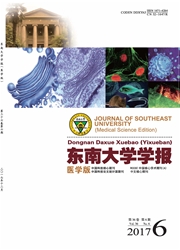

 中文摘要:
中文摘要:
目的探讨Egrl启动子介导的HSV-TK/GCV自杀基因系统与放疗联合治疗卵巢癌的疗效。方法以MTT方法测定细胞增殖抑制率,流式细胞仪分析细胞凋亡和坏死情况,倒置光学显微镜和电子显微镜观察治疗前后细胞形态学变化,并与单纯的辐射治疗比较。结果辐射一基因治疗对卵巢癌H08910细胞有生长抑制和凋亡诱导作用,效果明显优于单纯的放疗,干预60h、72h、96h后,辐射.基因治疗组的细胞增殖抑制率分别达到(56.88±5.35)%、(69.09±3.43)%、(86.91±0.75)%,而单纯辐射组对应的细胞增殖抑制率仅为(21.93±11.37)%、(37.99±7.24)%、(69.55±3.26)%。干预48h后,辐射.基因治疗组的细胞死亡率为26.01%(凋亡率:19.45%;坏死率:6.56%),明显高于单纯辐射组的12.47%(凋亡率:8.68%;坏死率:3.79%)和阴性对照组的4.41%(凋亡率:2.52%;坏死率:1.89%)。细胞形态学观察结果也显示辐射.基因治疗组细胞呈现了典型的凋亡形态学特征,细胞生长状态远不如单纯辐射组和阴性对照组。结论辐射.基因联合应用具有较好的协同和互补效应,比单一的放疗具有更强的抗肿瘤作用。
 英文摘要:
英文摘要:
Objective To investigate the therapeutical effect of radiotherapy combined with HSV-TK/GCW suicide gene system regulated by Egrl promoter on ovarian carcinoma. Methods HSV-TK/GCV suicide gene system regulated by the radiation promoter Egrl was combined with radiotherapy organically to intervene ovarian cancer cells in vitro. Methyl thiazolyl tetrazolium (MTT) assay and flow cytometry (FCM) assay were performed to examine the growth inhibition and the apoptosis of HO8910 cells, compared with that of radiotherapy alone. Optical microscope and electron microscope were used to observe cell morphological changes. Results Radiation-gene therapy has a good growth inhibition and apoptosis induction effect on ovarian cancer HO8910 cells, far better than that radiotherapy alone did. After intervened for 60 h, 72 h and 96 h, the cell proliferation inhibition ratio in the radiation-gene therapy group reached (56.88±5.35)%, (69.09 ±3.43)% and (86.91 ± 0.75)%, respectively, but that in the corresponding radiotherapy alone group was only (21.93±11.37)%, (37.99±7.24)% and (69.55 ± 3,26)%, respectively. Alter intervened for 48 h, the cell mortality rate of radiation-gene therapy group reached 26.01% (apoptosis rate: 19.45%; necrosis rate: 6.56%), significantly higher than 12.47% (apoptosis rate: 8.68%; necrosis rate: 3.79%) of the radiotherapy alone group and 4.41% (apoptosis rate: 2.52%; necrosis rate: 1.89%) of negative control group. The cells in the radiation - gene therapy group presented typical apoptosis morphological features and the cell growth condition was much worse than that in the radiotherapy alone group and that in the negative control group. Conclusion The combination application of radiation-gene has a good synergistic and complementary effect, with a stronger antitumor effect than that the single radiotherapy does.
 同期刊论文项目
同期刊论文项目
 同项目期刊论文
同项目期刊论文
 Using thermal energy produced by irradiation of Mn-Zn ferrite magnetic nanoparticles (MZF-NPs) for h
Using thermal energy produced by irradiation of Mn-Zn ferrite magnetic nanoparticles (MZF-NPs) for h The therapeutic effect of PEI-Mn0.5Zn0.5Fe2O4 nanoparticles/pEgr1-HSV-TK/GCV associated with radiati
The therapeutic effect of PEI-Mn0.5Zn0.5Fe2O4 nanoparticles/pEgr1-HSV-TK/GCV associated with radiati The anti-hepatoma effect of nanosized Mn-Zn ferrite magnetic fluid hyperthermia associated with radi
The anti-hepatoma effect of nanosized Mn-Zn ferrite magnetic fluid hyperthermia associated with radi Magnetic nanoparticles for targeted therapeutic gene delivery and magneticinducing heating on hepato
Magnetic nanoparticles for targeted therapeutic gene delivery and magneticinducing heating on hepato Preparation of PEI-Fe3O4/survivin-siRNA magnetic complex and its anti-tumor effect combined with MFH
Preparation of PEI-Fe3O4/survivin-siRNA magnetic complex and its anti-tumor effect combined with MFH Magnetic albumin immuno-nanospheres as an efficient gene delivery system for a potential use in lung
Magnetic albumin immuno-nanospheres as an efficient gene delivery system for a potential use in lung 期刊信息
期刊信息
